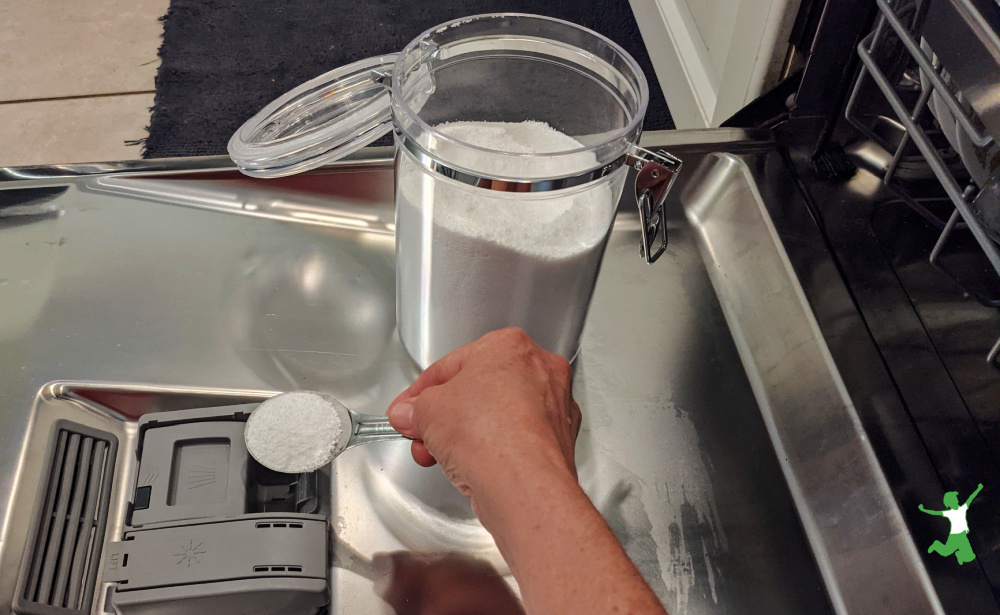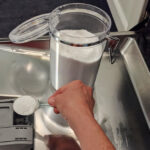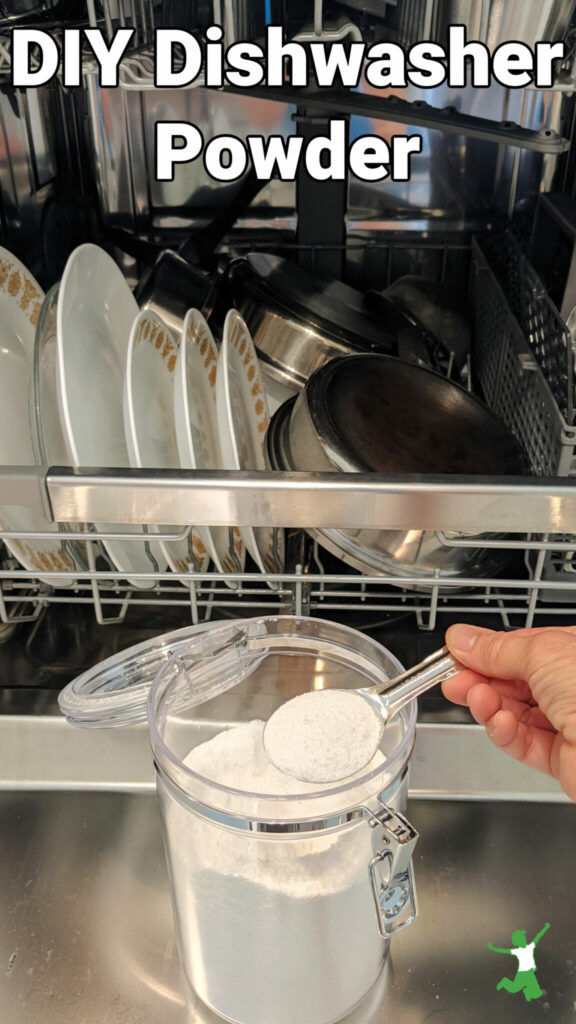A simple recipe for safe, green dishwasher powder that effectively cleans even the dirtiest dishes with no residue or streaking.

One product you absolutely should get rid of in your home is automatic dishwashing powder or tablets.
This stuff is one of the most toxic chemical concoctions people use in their homes, using it day after day, year after year…usually without giving it a second thought.
Is this stuff safe to use on the very dishes and utensils we use to eat?
What good is buying everything organic, local, and nutrient-dense if the kitchenware you serve it on has dangerous residue?
While companies that make these products assure us that the chemicals rinse clean and clear, I don’t believe their corporate claims (and never have).
Even the ingredients in “green” dishwashing powders I’ve examined are toxic …. although much less so than supermarket brands.
Some of them contain glycerin, which is sticky and increases the chances of residue on your dishes. It does not rinse off easily!
It is important to remember that the marketing term “eco-friendly” does not necessarily mean “human-friendly”.
I have yet to find a brand of dishwasher powder that is 100% safe that I feel comfortable using.
If you think you have found one, please share it along with a list of ingredients in the comments!
However, it is so easy and inexpensive to make your own, I don’t know why more people don’t do it.
Another tip…I do not recommend 100% trust in the ingredient safety database from Environmental Working Group.
While it is a good source of information, it is sometimes wrong too.
A couple of the ingredients I’ve researched using it have come up “green”, however, when I searched them further they were far from safe!
I’m not saying don’t use it, just avoid using it as the only or final authority on a particular chemical you might be investigating.
Give it a try making your own dishwashing powder! The formula below works well even for the very hard well water we have in our home. It is also safe for septic tanks.
Does it work as well as commercial brands?
No, it doesn’t. But, it works well enough in my experience.
Just be sure to scrape the dishes before starting a load.
This is a little extra work I would far prefer doing compared to using a product that will remove everything under the sun but potentially leave toxins on our plates, cups, and utensils!

Homemade Dishwashing Powder
A simple recipe for safe, green dishwasher powder that effectively cleans even the dirtiest dishes with no residue or streaking.
Ingredients
- 2 cups washing soda
- 1/2 cup citric acid food grade, nonGMO
- white vinegar optional
Instructions
-
Mix washing soda and citric acid in a small container with a tight fitting lid.
-
Add 1 tablespoon of the dry mixture per dishwasher load to the main detergent compartment. Use 2 tablespoons if the load is heavy or especially dirty.
-
Fill the dishwasher rinse compartment with the white vinegar. This is optional, but recommended if you have hard water.
Recipe Notes
**Stir the powder every time or every other time you use it to prevent clumping.









What about Seventh Generation dishwasher detergent?
Sodium chloride
sodoum sulfate
sodium carbonate
citric acid
sodium percarbonate
c12-16 alcohols ethoxylated propoxylated
sodium silicate
sodium polyaspartate
protease enzyme blend
amylase enzyme blend
Also what dish soap do you use for hand washing? What do you think of the 9 Elements brand?
1.Water 2.Plant Based Cleaning Agent: Sodium Lauryl Sulfate 3.Plant Based Cleaning Agent: Caprylyl/Capryl Glucoside 4.Plant Based Water Softener: Sodium Citrate 5.Plant Based Cleaning Agent: Lauramidopropyl Betaine 6.Citrus Limon (Lemon) Peel Oil 7.Plant Based Cleaning Agent: Citric Acid 8.Vinegar
Unscented castile soap is great for hand washing dishes. Not a fan of Seventh Generation dishwashing powder. At least one toxic ingredient that doesn’t pass my zero toxicity test for chemicals that wash my dishes and utensils.
We use thrive market rosey unscented. The ingredients-Sodium Chloride, Sodium Carbonate, Citric Acid,
Sodium Carbonate Peroxide, Sodium Sulfate, Protease Enzyme
Thank you, Sarah!
What are your thoughts on these two brands:
https://www.mamasuds.com/products/automatic-dishwasher-powder
https://shop.purehaven.com/#/shop/detail/95434/from/14677?ReferringCustomerDID=828703
What is your take on the Norwex dish detergent?
Sodium Carbonate (Mineral-derived) (Water softener) (497-19-8), Sodium Citrate (Plant-derived) (Water softener) (68-04-2), Sodium Carbonate Peroxide (Mineral-derived) (Oxygen cleaner) (15630-89-4), Alcohols C10-12 Ethoxylated Propoxylated (Partially Plant-derived) (Surfactant) (68154-97-2), Tetrasodium Iminodisuccunate (Partially Plant-derived) (Water softener) (144538-82-0), Sodium Silicate (Mineral-derived) (Corrosion inhibitor) (1344-09-8), Citric Acid (pH adjuster) (pH adjuster) (77-92-9), Subtilisin (Enzyme) (Breaks down protein-based soils) (9014–01-1), Amylase (Enzyme) (Breaks down starch-based soils) (9000-90-2).
Tetrasodium iminidisuccinate is considered hazardous under the criteria of the U.S. Federal OSHA Hazard Communication Standard 29 CFR 1910.1200.
As long as you choose a food grade none GMO does it matter what brand of citric acid is used?
Yes, nonGMO and food grade are very important. Other than that, any brand is most likely fine.
Sarah, this is a little off topic, but still relevant to toxins. The dishes in the picture look like (but may not be) vintage Corning ware. Many people believe and have found through independent testing that dishes made before 2000 have unsafe levels of lead in them including Corning ware.
Yes, I’ve seen that “home testing” info … not credible IMO. I grew up eating on these very dishes. I do not test high in lead or other heavy metals.
Had the same question. Thanks for the asking and the answering. Have been following the lead issue lady for awhile curiously. Never sure what to think. This is reassuring.
Do you have an opinion on AzureClean Dishwasher powder?
Ingredients: sodium carbonate, plants: sodium percarbonate, sodium gluconate, methylglycinediacetic acid, sodium salt, sodium citrate, amylase and protease, block copolymer, minerals: sodium sulfate, sodium metasilicate, sodium silicate, biodegradable synthetics: sodium polyacrylate, TAED
Hi Rachel, this is better than most, but not something I would use. For example, TAED is Tetraacetylethylenediamine…. environmental hazard. Dangerous if ingested (residue potential?)
Might be issues with some of the other ingredients too. I just looked at the most likely one first, and it was already a red flag.
Thank you for asking (and Sarah for answering!), I also use Azure brand but am going to try this recipe. Unfortunately, even good companies like Azure can’t be blindly trusted to manufacture clean products and even food for that matter. Bummer.
Good point! Some companies have a few excellent products and others under the same brand are unacceptable. It is best to judge and evaluate products on a case by case basis for this reason.
This has been my never ending quest it seems. I have tried so many diy dishwasher detergent recipes. I was using just washing soda and citric acid with vinegar in the rinse aid compartment and it seemed to work well at first but then the white scaling started and was having to rewatch dishes all the time. My ratios didn’t have as much citric acid to soda so that might have helped, since I had do so some just heavy citric acid washes and scrub the insides to get rid of the scaling and other buildup. Then in my research of what to do next, I read that those two ingredients weren’t enough to truly clean the dishes..that washing soda is just a softener I think. Also have read repeatedly that ask great as it seems, vinegar can wear down rubber gaskets so can damage both dishwasher and washing machine. I needed a break so I tried a new “green” one I hadn’t tried before. It’s Shaklee’s detergent. What do you think? I’ve been using it over a month now and had no problems and the dishwasher hasn’t gotten any build up or scaling. What do you think? We try so hard but in this imperfect world, sometimes we just have to do the best we can -please don’t burst my bubble too much 😅.
https://us.shaklee.com/Green-Home/Household-Cleaning/Dishes/Dish-Washer-Automatic-Powder-Concentrate/p/00295
Definitely one of the better ones I’ve seen. I understand your perspective. My view is that since this stuff is washing dishes and utensils it has to be perfect. I didn’t check them all, but the first suspicious ingredient I researched was an irritant and corrosive (tetrasodium EDTA). I will stick with DIY though it is indeed imperfect.
What is your opinion about Dropps?
INGREDIENTS:
Sodium carbonate*, sodium percarbonate*, poly(itaconic acid-co-AMPS) sodium salt*, trisodium citrate dihydrate*, alkoxylated alcohol*, subtilisin, silicic acid*, tetraacetylethylenediamine*, alpha amylase, polyvinyl alcohol film (PVOH).
*Denotes plant or mineral origin.
That one is a hard no. Tetraacetylethylenediamine (TAED) is an environmental hazard and dangerous if ingested. Note how the manufacturer puts the asterisk that it is of “plant based origin” like this somehow makes the chemical safe? Beware of marketing psyops like this!
I use Shaklee products too, they are great and nontoxic!
Unfortunately, if you check some of the earlier comments, I looked at that product, and it doesn’t make the grade at least for me. Definitely has ingredients I don’t want touching my dishes and utensils.
I’m so glad you mentioned the rubber gaskets. I found that when I started using citric acid, a while ago, the rubber deteriorated. I had been so pleased that the mineral deposits were less of a problem, but dishwasher actually started leaking from gaskets breaking down. I hand wash now. That frustrated. I grew up handwashing, so…
I noticed our silverware turning darker from tablet use. I recently viewed a warning video on citric acid and mold. Your link may be a safer choice.
A tip that a dishwasher repairman gave me one time was, when using natural detergent, use the extra hot washing option (you can still let it air dry). He said the natural detergents really need the hot water to activate it to its fullest.
I have been using Grab Green pods:
sodium citrate cleans
sodium carbonate peroxide cleans/removes grease
sodium sulfate absorbs excess water
sodium carbonate water softener
sodium silicate cleans
linear alcohol ethoxylate cleans
tetrasodium iminodisuccinate removes minerals from water
hydrated silica anti-caking
sodium polyaspartate prevents food from resticking
fragrance contains a blend of essential oil juniperus virginiana (cedarwood) + man-made ingredients
amylase enzyme blend removes starches
subtilisin enzyme blend removes grease/proteins
polyvinyl alcohol forms the pod
Definitely a safer choice, but not completely without issue or health hazards. 🙁
Given that it washes the dishes and utensils, I personally would not feel comfortable using it.
Just took a look at BioKleen. Also a no-go, in my opinion. The first suspicious-looking chemical I looked at came back as a health and environmental hazard (limonene). Misdirection ploy on the label as a “plant derived” ingredient. This does not mean a chemical is safe.